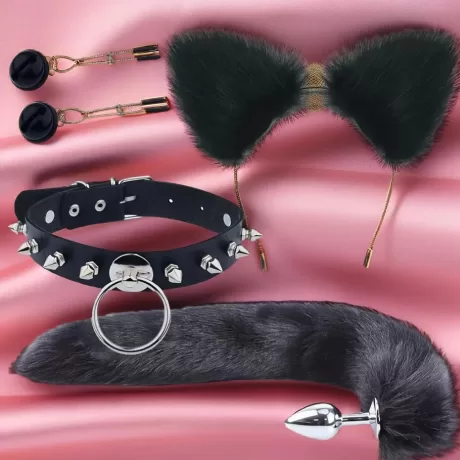How to Choose the Right BDSM Collar: PVC vs. Leather vs. Steel
So, you’re interested in looking at BDSM collars, but the materials offered may seem like a lot. Unlike seasoned kinksters, or even nosey newbies, the collar you pick is not merely about style. It also addresses comfort, function, personal dynamics, and relationships. Let’s walk through the three most common options: PVC, Leather, and Steel.

1. PVC Collars: Lightweight and Inexpensive
If you are interested in BDSM, or are cautious about maintenance in BDSM practices, then pvc collars are best for you. They are made of synthetic plastics, which makes collars lightweight and water-resistant. With their long-term value, these collars offer durability and are easy to clean, making them ideal for sweat-heavy action.
Pros:
Cost Effective: A great option for experimentation with accessories, and best of all, these won’t bloat your spending.
Available Colors: These PVC collars can be found in neon colors or even patterned to faux leather.
Safe for Allergens: These collars do not use animal products , thus making it a safe choice for vegans and allergy sensitive users.
Cons:
Longevity: Users who are rough with taps will eventually strip these collars down to braided fake leather strips.
Inauthentic Experience: Touching plastic doesn’t give the satisfactory feeling a sensory product claims to give.
Best for: Testing preferences at the step-up stage before purchasing more expensive equipment.
2. Leather Collars: Classic & Versatile
The embrace of leather, “the lovemark” of BDSM culture. Leather collars maintain balance of comfort, strength, and meaning. They provide the tactile pleasure associated with dominance and submission relationships.
Pros:
Durability: When well maintained, genuine leather age wonderfully, gaining a unique patina.
Sensory experience: The scent, feel, and warmth of leather heightens psychological immersion.
Customization: Variation in widths, colors, and hardware (buckle, D-ring, spike, etc.) is available.
Cons:
Maintenance: Needs conditioning to prevent drying and cracking.
Cost: Genuine leather is pricier than PVC (though faux leather provides a middle-ground).
Allergies: Some won’t take skin-friendly tanning chemicals. Not vegan-friendly.
Best for: Traditionalists that appreciate the rituals consider long-term dynamics best for them.
3. Steel Collars: Unyielding & Symbolic
If collars had a ‘heavyweight championship’, Steel would win it all—literally. They are incorporated in 24/7 Master/slave relationships as a symbol of permanent/semi-permanent commitment. Think padlocked, welded designs, or minimalist bands.
Pros:
Permanence: A dominant symbol of ownership or devotion.
Hygienic: Easily sanitized and resistant to perspiration, blood, or other bodily fluids.
Strength: Ideal for intense play or bondage setups because of the nearly indestructible structure.
**Cons:**
**Weight:** Wearing it for long hours can put stress on the user’s neck.
**Discomfort Issues:** Poor alignment can lead to padding lacking or edges slicing into skin.
**Temperature:** Feels cold and may chill during winter; can be uncomfortable for some.
**Best Fit:** Advanced users or for unending protocols or ritualistic ceremony.
**Key Questions Before Purchasing**
**What’s the primary function?** Is it for play, daily wear, or symbolic rituals?
**Who’s wearing it?** What is the neck’s skin sensitivity? Allergies? Personal preference?
**What budget do you have in mind?** From short-lived cheap PVC to lifelong costly steel.
**How crucial is looks?** Flashy PVC, rugged leather, and sleek steel.
**Professional Advice for Precision**
**Measure twice:** Using a soft tape, check neck measurement accounting for swelling.
**Test the hardware:** Fasteners like locks, O-rings, and buckles must be rust-proof and secure.
**Safety first:** Choose a beginner’s steel option without sharp edges as quick-release sole.
**Compelling Final Thoughts**
Select a BDSM collar based on dynamics, identity, and needs with materials. No matter the choice, communicate with your partner, prioritize safety, and remember: “Right” is the collar that serves the user best.
